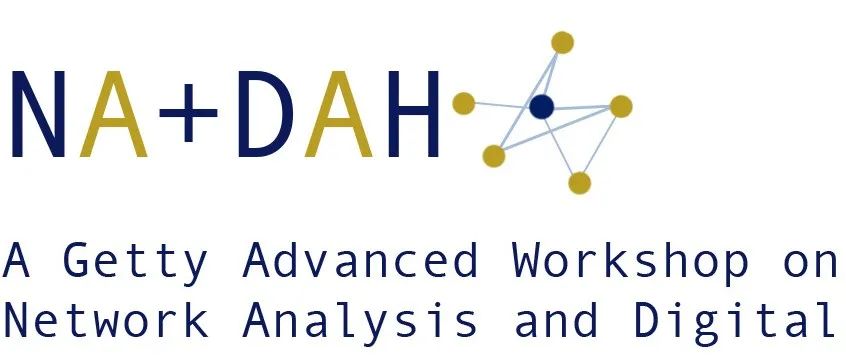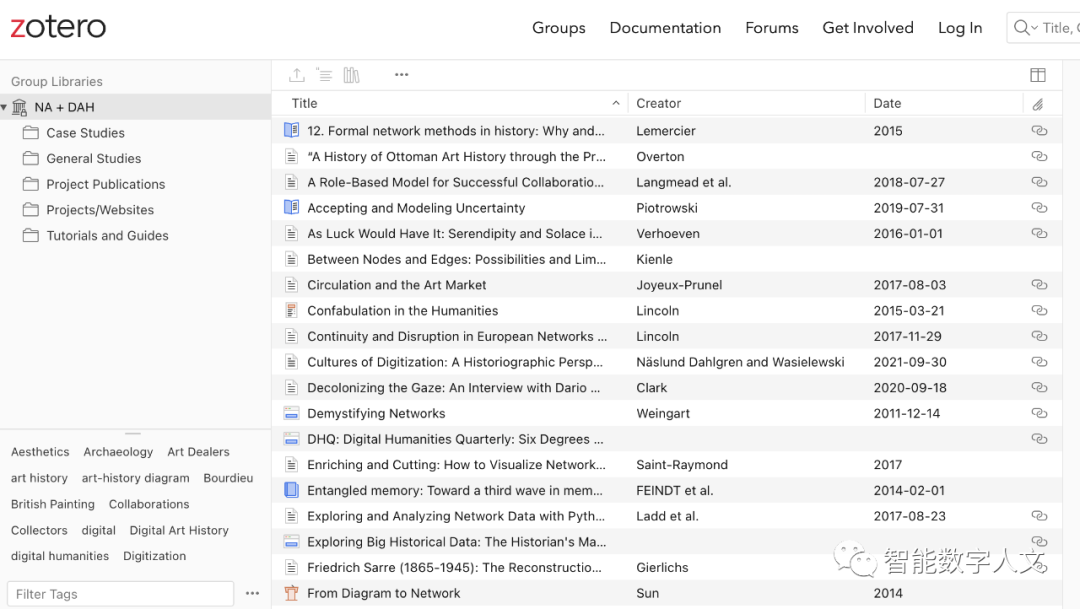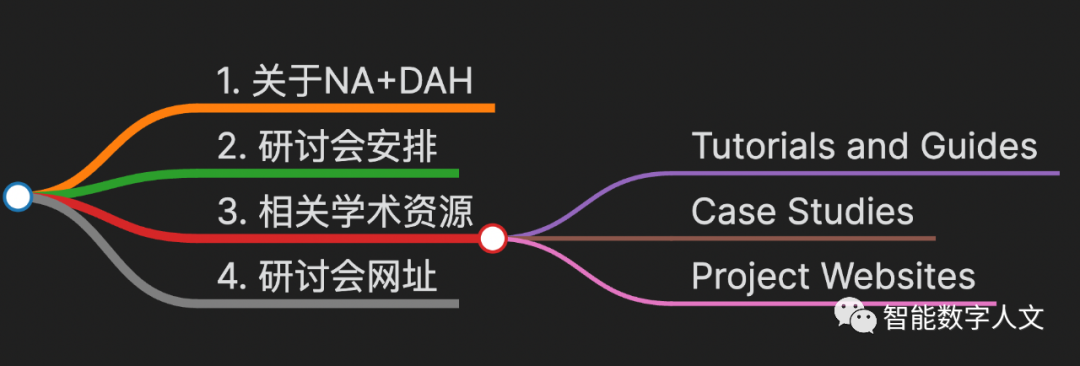
NA+DAH研讨会是盖蒂基金会支持的一项活动,虽然目前可能已经结束,但是该研讨会组织的活动以及分享的研究资料,特别是以Zotero文献库组织的参考文献对网络分析与艺术史相结合的学习和研究人员可能会有比较大的帮助,文中有这些相关资料的介绍和链接。Zotero库地址:https://www.zotero.org/groups/2311761/na__dah/library
(欢迎就相关问题留言讨论)

本条推文内容结构如下图所示:

1. 关于NA+DAH
NA+DAH研讨会是盖蒂基金会支持的一项活动,它将把艺术史学家、网络科学家和数字人文主义者聚集在一起,推动这些领域的交叉研究。
Alison Langmead(匹兹堡大学)、Anne Helmreich(盖蒂研究所)和Scott B. Weingart(卡内基梅隆大学)为活动提供指导,他们都是从事数字艺术史和网络分析的学者。网络分析+数字艺术史研讨会将在一整年内展开,并将以在匹兹堡大学举行的两次面对面的会议为框架,这将使参与者学习高级数字方法和项目管理技能,同时培养一个紧密的跨学科研究社群。在研讨会结束时,参与者将拥有在网络分析和艺术史的交叉领域进行复杂研究和建立先进项目所需的专业支持。
NA+DAH研讨会将有八个项目团队(涵盖艺术史、技术和分析方面的专业知识)参加一系列面对面的和视频的会议,各团队也将在会议框架之外进行合作,以发展和推进相关的研究项目。可以预期盖蒂数字艺术史高级专题研讨会将产生大量的研究,我们预计可能会有一个论文集或在线资源库来分享相关成果。

研讨会Logo
2. 研讨会安排
-
[One-week convening, July 29–August 2, 2019](https://sites.haa.pitt.edu/na-dah/?page_id=83)
-
Monthly virtual convenings, Fall–Spring 2019–2020
-
[Online convening, June 22–June 26, 2020](https://sites.haa.pitt.edu/na-dah/convening-2-june-2020/)
-
Webinars and project team meetings, Summer–Spring 2020–2021
-
End-of-Workshop deliverable planning, May-June 2021
-
[Online convening, June 21-25, 2021](https://sites.haa.pitt.edu/nadah/summer-2021-online-convening-schedule/)
-
Ongoing project work and additional webinars, July-December 2021
3. 相关学术资源
网络分析相关 (General Studies on Network Analysis)
-
Brughmans, Tom, et al., editors. The Connected Past: Challenges to Network Studies in Archaeology and History. First edition, Oxford University Press, 2016.
-
Crookham, Alan, and Stuart Dunn. “Reframing Art: Opening Up Art Dealers’ Archives to Multi-Disciplinary Research.” Visual Resources, vol. 35, no. 1–2, Apr. 2019, pp. 180–83. Taylor and Francis+NEJM, doi:10.1080/01973762.2019.1553447.
-
Easley, David, and Jon Kleinberg. Networks, Crowds, and Markets: Reasoning about a Highly Connected World. Cambridge University Press, 2010.
-
FEINDT, GREGOR, et al. Entangled Memory: Toward a Third Wave in Memory Studies. 2014, doi:10.1111/hith.10693.
-
Global Trends in Museum Diplomacy: Post-Guggenheim Developments, 1st Edition (Hardback) – Routledge. https://www.routledge.com/Global-Trends-in-Museum-Diplomacy-Post-Guggenheim-Developments-1st-Edition/Grincheva/p/book/9780815370949. Accessed 7 Aug. 2019.
-
Jackson, Cornell. “Using Social Network Analysis to Reveal Unseen Relationships in Medieval Scotland.” Digital Scholarship in the Humanities, vol. 32, no. 2, Oxford Academic, June 2017, pp. 336–43. academic.oup.com, doi:10.1093/llc/fqv070.
-
Joyeux-Prunel, Béatrice. “Circulation and the Art Market.” Journal for Art Market Studies, vol. 1, no. 2, Aug. 2017. fokum-jams.org, doi:10.23690/jams.v1i2.13.
-
Kienle, Miriam. Between Nodes and Edges: Possibilities and Limits of Network Analysis in Art History. no. 3.
-
Lemercier, Claire. “12. Formal Network Methods in History: Why and How?” Social Networks, Political Institutions, and Rural Societies, edited by Georg Fertig, vol. 11, Brepols Publishers, 2015, pp. 281–310. Crossref, doi:10.1484/M.RURHE-EB.4.00198.
-
Lincoln, Matthew D. “Confabulation in the Humanities.” Matthew Lincoln, 21 Mar. 2015, http://matthewlincoln.net/2015/03/21/confabulation-in-the-humanities.html.
-
Mills, Barbara J. “Social Network Analysis in Archaeology.” Annual Review of Anthropology, vol. 46, no. 1, 2017, pp. 379–97. Annual Reviews, doi:10.1146/annurev-anthro-102116-041423.
-
Moravec, Michelle. “Network Analysis and Feminist Artists.” Artl@s Bulletin, vol. 6, no. 3, 2017.
-
Moretti, Franco. “Graphs, Maps, Trees, Abstract Models for Literary History.” New Left Review, vol. 24, Dec. 2003, pp. 67–93.
-
—. Network Theory, Plot Analysis. p. 42.
-
Östborn, Per, and Henrik Gerding. “Network Analysis of Archaeological Data: A Systematic Approach.” Journal of Archaeological Science, vol. 46, June 2014, pp. 75–88. ScienceDirect, doi:10.1016/j.jas.2014.03.015.
-
Pezzini, Barbara. “The ‘Art’ and the ‘Market’ Elements of the Art Market: John Linnell, William Agnew and Artist-Dealer Relationships in Nineteenth-Century Britain.” Journal for Art Market Studies, vol. 2, no. 4, Dec. 2018. www.fokum-jams.org, doi:10.23690/jams.v2i4.40.
-
Piotrowski, Michael. Accepting and Modeling Uncertainty. 2019, http://dx.doi.org/10.17175/sb004_006.
-
Porras, Stephanie. “Keeping Our Eyes Open: Visualizing Networks and Art History.” Artl@s Bulletin, vol. 6, no. 3.
-
Schich, Maximilian, et al. Network Dimensions in the Getty Provenance Index. June 2017. arxiv.org, https://arxiv.org/abs/1706.02804v1.
-
Sielke, Sabine. “Network and Seriality: Conceptualizing (Their) Connection.” Amerikastudien/American Studies, vol. 60, no. 1, 2015, pp. 81–95.
-
Smith, Brian Cantwell. “The Limits of Correctness.” ACM SIGCAS Computers and Society, vol. 14,15, no. 1,2,3,4, Jan. 1985, pp. 18–26. Crossref, doi:10.1145/379486.379512.
-
Sun, Yanan. “From Diagram to Network.” Social Informatics, edited by Akiyo Nadamoto et al., Springer Berlin Heidelberg, 2014, pp. 100–09.
-
Towards Interoperable Network Ontologies for the Digital Humanities | International Journal of Humanities and Arts Computing. https://www.euppublishing.com/doi/abs/10.3366/ijhac.2016.0157. Accessed 1 Apr. 2019.
-
Verhoeven, D. “As Luck Would Have It: Serendipity and Solace in Digital Research Infrastructure.” Feminist Media Histories, vol. 2, no. 1, Jan. 2016, pp. 7–28. DOI.org (Crossref), doi:10.1525/fmh.2016.2.1.7.
-
Vespignani, Alessandro. “Modelling Dynamical Processes in Complex Socio-Technical Systems.” Nature Physics, vol. 8, no. 1, Jan. 2012, pp. 32–39. DOI.org (Crossref), doi:10.1038/nphys2160.
教程 (Tutorials and Guides)
-
Baca, Murtha. Introduction to Metadata. 20 July 2016, http://www.getty.edu/publications/intrometadata.
-
Düring, Marten. “From Hermeneutics to Data to Networks: Data Extraction and Network Visualization of Historical Sources.” Programming Historian, Feb. 2015. programminghistorian.org, https://programminghistorian.org/en/lessons/creating-network-diagrams-from-historical-sources.
-
“GEPHI – Introduction to Network Analysis and Visualization.” Martin Grandjean, http://www.martingrandjean.ch/gephi-introduction/. Accessed 1 Aug. 2019.
-
Ladd, John, et al. “Exploring and Analyzing Network Data with Python.” Programming Historian, Aug. 2017. programminghistorian.org, https://programminghistorian.org/en/lessons/exploring-and-analyzing-network-data-with-python.
-
Langmead, Alison, et al. “A Role-Based Model for Successful Collaboration in Digital Art History.” International Journal for Digital Art History, no. 3, July 2018. journals.ub.uni-heidelberg.de, doi:10.11588/dah.2018.3.34297.
-
Newman, M. E. J. Networks. Second edition, Oxford University Press, 2018.
-
Posner, Miriam. “Miriamposner/Cytoscape_tutorials.” 2016. GitHub, 19 June 2019, https://github.com/miriamposner/cytoscape_tutorials.
-
Saint-Raymond, Lea. Enriching and Cutting: How to Visualize Networks Thanks to Linked Open Data Platforms. no. 3, 2017.
-
Simple Gephi Project from A to Z. https://seinecle.github.io/gephi-tutorials/generated-html/simple-project-from-a-to-z-en.html. Accessed 31 Mar. 2019.
-
Weingart, Scott. “Demystifying Networks.” The Scottbot Irregular, 14 Dec. 2011, http://www.scottbot.net/HIAL/?p=6279.
案例研究(Case Studies)
-
Ahnert, Ruth, and Ahnert, Sebastian. “Metadata, Surveillance and the Tudor State.” History Workshop Journal, vol. 87, no. Spring 2019, pp. 27–51.
-
Brosens Koenraad, et al. “The Brussels Guild of Painters, Goldbeaters, and Stained-Glass Makers, 1599 – 1706: A Multi-Faceted Analysis.” Zeitschrift Für Kunstgeschichte, vol. 82, no. 4, 2019, p. 531, doi:10.1515/ZKG-2019-4003.
-
Fletcher, Pamela, and Anne Helmreich. “Local/Global: Mapping Nineteenth-Century London’s Art Market.” Nineteenth-Century Art Worldwide, vol. 11, no. 3.
-
Gierlichs, Joachim. “Friedrich Sarre (1865-1945): The Reconstruction of His Collection of Islamic Art.” Szántó, Iván & Yuka Kadoi (Eds.): The Reshaping of Persian Art. www.academia.edu, https://www.academia.edu/40189224/Friedrich_Sarre_1865-1945_The_Reconstruction_of_His_Collection_of_Islamic_Art. Accessed 8 May 2020.
-
Giuffre, Katherine. “Sandpiles of Opportunity: Success in the Art World.” Social Forces 77, no. 3 (1999): 815-32. https://doi.org/10.2307/3005962.
-
Howald, Christine, and Lea Saint-Raymond. “Tracing Dispersal: Auction Sales from the Yuanmingyuan Loot in Paris in the 1860s.” Journal of Art Market Studies, vol. 2, 2018.
-
Hulst, Titia. “The Vicissitudes of Taste: The Market for Pop.” Journal for Art Market Studies, vol. 1, no. 2, Aug. 2017. fokum-jams.org, doi:10.23690/jams.v1i2.10.
-
Lincoln, Matthew. “Continuity and Disruption in European Networks of Print Production, 1550-1750.” Artl@s Bulletin, vol. 6, no. 3, Nov. 2017, p. Article 2.
-
—. “Social Network Centralization Dynamics in Print Production in the Low Countries, 1550-1750.” International Journal for Digital Art History, no. 2, Oct. 2016. journals.ub.uni-heidelberg.de, doi:10.11588/dah.2016.2.25337.
-
Overton, Keelan. “‘A History of Ottoman Art History through the Private Database of Edwin Binney, 3rd.’ Journal of Art Historiography, No. 6, June 2012, Pp. 1-19, Special Volume Dedicated to Islamic Art Historiography, Eds. Moya Carey and Margaret Graves.” Journal of Art Historiography. www.academia.edu.
-
Pezzini, Barbara. “The ‘Art’ and the ‘Market’ Elements of the Art Market: John Linnell, William Agnew and Artist-Dealer Relationships in Nineteenth-Century Britain.” Journal for Art Market Studies, vol. 2, no. 4, Dec. 2018. www.fokum-jams.org, doi:10.23690/jams.v2i4.40.
-
Rhodes II, Mark Alan. “Paul Robeson’s Place in YouTube: A Social Spatial Network Analysis of Digital Heritage.” DSH, vol. 34, no. 1, 2019, pp. 174–88.
-
Yael, Rice. “Workshop as Network: A Case Study from Mughal South Asia.” Artl@s Bulletin, vol. 6, no. 3.
研究项目(Project Websites)
-
DHQ: Digital Humanities Quarterly: Six Degrees of Francis Bacon: A Statistical Method for Reconstructing Large Historical Social Networks. http://digitalhumanities.org/dhq/vol/10/3/000244/000244.html. Accessed 1 Aug. 2019.
-
“Exploring Big Historical Data: The Historian’s Macroscope.” Exploring Big Historical Data: The Historian’s Macroscope, http://www.themacroscope.org/2.0/. Accessed 1 Aug. 2019.
-
Itinera. https://itinera.pitt.edu/. Accessed 23 Sept. 2019.
-
Kaplan, Frédéric. “The Venice Time Machine.” Proceedings of the 2015 ACM Symposium on Document Engineering, ACM, 2015, pp. 73–73. ACM Digital Library, doi:10.1145/2682571.2797071.
-
Mapping Art Markets in Europe. http://www.artmarkets.eu/presentation/?lang=en. Accessed 23 Sept. 2019.
-
Mapping the Republic of Letters. http://republicofletters.stanford.edu/. Accessed 23 Sept. 2019.
-
MoMA | Inventing Abstraction | Connections. https://www.moma.org/interactives/exhibitions/2012/inventingabstraction/?page=connections. Accessed 23 Sept. 2019.
-
The Sphere: Knowledge System Evolution and the Shared Scientific Identity in Europe | MPIWG. https://www.mpiwg-berlin.mpg.de/project/the-sphere. Accessed 3 May 2019.
-
Time Machine Europe. https://www.timemachine.eu/. Accessed 23 Sept. 2019.
-
Visualizing Historical Networks. http://histecon.fas.harvard.edu/visualizing/index.html. Accessed 23 Sept. 2019.
-
VTM – Venice Time Machine. https://vtm.epfl.ch/. Accessed 23 Sept. 2019.
-
Warren, Christopher N., et al. “Six Degrees of Francis Bacon: A Statistical Method for Reconstructing Large Historical Social Networks.” Digital Humanities Quarterly, vol. 010, no. 3, July 2016.
原文始发于微信公众号(智能数字人文):盖蒂基金会支持的网络分析与艺术史研讨会